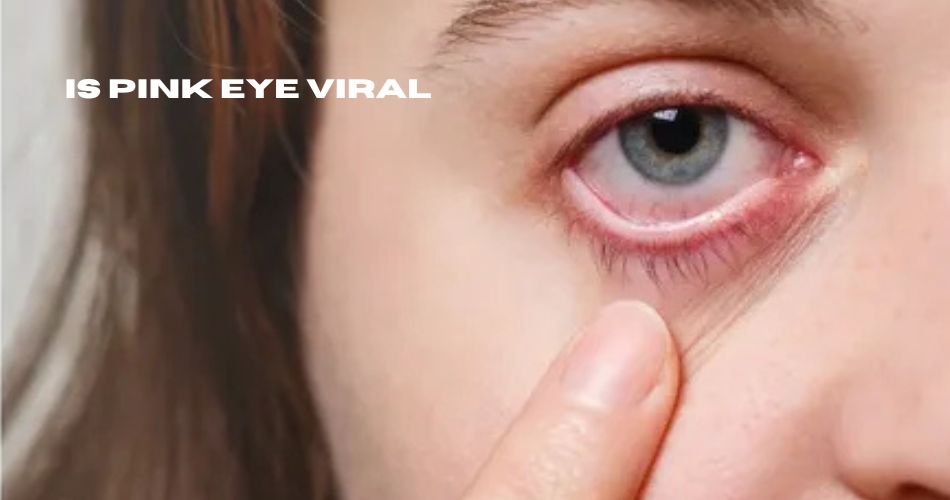Pink eye medically known as conjunctivitis, is a term that most of us have heard at some point in our lives. It’s that uncomfortable, annoying condition where your eye becomes red, inflamed, and sometimes watery or sticky. But what exactly causes it? And importantly, is pink eye viral? This question often pops up because pink eye can be caused by different factors including bacteria, allergens, and viruses. In this detailed article, we’ll explore everything you need to know about viral pink eye—how it happens, what symptoms to watch for, how it spreads, and what you can do about it. Whether you’re trying to understand your own symptoms or just curious, this guide has got you covered.
What Is Pink Eye Viral?
When we talk about is pink eye viral, we’re referring to conjunctivitis caused by viruses. Unlike bacterial infections, viral infections don’t respond to antibiotics and usually must run their course naturally. Viral pink eye is often highly contagious, meaning it can spread quickly from person to person, especially in close-contact environments like schools, offices, or crowded households. The main culprits behind viral conjunctivitis are adenoviruses, which are common viruses that can also cause respiratory infections like the common cold. When these viruses infect the conjunctiva—the thin, clear layer covering the white part of your eye—they cause redness, irritation, and watery discharge.
Different Types of Pink Eye: Viral, Bacterial, and Allergic
It’s crucial to understand that not all pink eye is viral. Conjunctivitis comes in three main types: viral, bacterial, and allergic. Each type has different causes and requires different treatments. Bacterial conjunctivitis, for example, is caused by bacteria such as Staphylococcus or Streptococcus, and it usually produces thick, yellow or greenish discharge that can crust over your eyelashes. This type often requires antibiotics to heal. Allergic conjunctivitis, on the other hand, results from allergens like pollen, dust, or pet dander and is not contagious. It typically causes intense itching, redness, and watery eyes, often accompanied by other allergy symptoms like sneezing and nasal congestion. Viral conjunctivitis generally produces watery discharge, redness, and a gritty sensation in the eyes and can spread rapidly from one eye to the other.
How Does Viral Pink Eye Spread?
One of the biggest concerns with is pink eye viral is how easily it spreads. The infection is highly contagious and can be passed through direct contact with an infected person’s eye secretions or indirectly via contaminated objects like towels, pillowcases, or makeup. Even touching your eyes with unwashed hands after coming into contact with the virus can result in infection. The virus can also spread through droplets from coughing or sneezing. Because of this, outbreaks are common in crowded places where hygiene is compromised. Understanding how it spreads helps you take effective precautions to protect yourself and others.
Common Viruses Behind Viral Pink Eye
The adenovirus family is the main viral culprit behind most cases of viral conjunctivitis. These viruses are widespread and responsible for various illnesses, including respiratory infections and gastroenteritis. Other viruses that can cause conjunctivitis include the herpes simplex virus, which is known for causing cold sores, and the varicella-zoster virus, which causes chickenpox and shingles. When these viruses invade the conjunctival tissue, they trigger inflammation, redness, and tearing as the body attempts to fight off the infection.
Symptoms That Signal Viral Pink Eye
Recognizing the symptoms of viral pink eye early can help you manage it better and avoid spreading it. Typically, viral conjunctivitis starts in one eye and may spread to the other within a few days. The affected eye appears red or pink due to inflamed blood vessels. Watery discharge is common, unlike the thick pus seen in bacterial infections. You may also experience a gritty or burning sensation, as if there is sand in your eye. Other symptoms include swollen eyelids, mild sensitivity to light, and occasional blurry vision. Sometimes, viral conjunctivitis can accompany symptoms of a cold or respiratory infection, such as a sore throat, cough, or runny nose.
Distinguishing Viral Pink Eye from Other Types
It can be tricky to tell is pink eye viral apart from bacterial or allergic conjunctivitis based on symptoms alone, but there are some clues. Viral conjunctivitis tends to cause watery discharge, whereas bacterial causes produce thicker, colored discharge. Allergic conjunctivitis usually involves intense itching and affects both eyes simultaneously. If you’re unsure which type you have, consulting a healthcare professional is important because the right diagnosis ensures you get the appropriate treatment and reduce the risk of complications.
How Doctors Diagnose Viral Pink Eye
When you visit a doctor for pink eye symptoms, they usually start with a detailed history and physical examination. They’ll ask about the onset of symptoms, any recent illness or contact with someone infected, and check the appearance of your eyes. In certain cases, especially if symptoms are severe or not improving, doctors may take a sample of eye secretions for laboratory analysis to confirm the cause—whether viral, bacterial, or allergic. This step helps guide treatment decisions and prevents unnecessary use of antibiotics.
Treatment Strategies for Viral Pink Eye
The good news is that viral pink eye often clears up on its own within one to two weeks. Unfortunately, antibiotics don’t work against viruses, so the treatment mainly focuses on symptom relief. Using lubricating eye drops or artificial tears can soothe irritation and wash away discharge. Warm or cool compresses applied gently to the eyes help reduce swelling and discomfort. It’s essential to avoid wearing contact lenses until your eyes have fully healed to prevent further irritation or infection. Maintaining strict hygiene practices is critical to avoid spreading the virus to others.
Home Remedies That Help Soothe Viral Pink Eye
If you’re dealing with is pink eye viral at home, several remedies can provide relief. Gently rinsing your eyes with clean, lukewarm water can help remove irritants. Avoid rubbing your eyes as tempting as it might be because this can worsen inflammation or spread the infection. Applying a cold compress can reduce redness and swelling, while warm compresses may ease discomfort for some people. Frequent handwashing and avoiding sharing personal items like towels or pillowcases are also vital. These simple steps can significantly speed up your recovery and protect others around you.
When to Seek Medical Help for Pink Eye
Although is pink eye viral is usually mild and self-limiting, there are situations when you should see a doctor promptly. If you experience severe eye pain, significant sensitivity to light, vision changes, or if symptoms worsen or last longer than two weeks, medical attention is necessary. People with weakened immune systems or pre-existing eye conditions should also seek care early to avoid complications. Prompt diagnosis and monitoring can ensure your eyes stay healthy and complications are prevented.
Duration: How Long Does Viral Pink Eye Typically Last?
Viral conjunctivitis generally runs its course in about 7 to 14 days. Symptoms may peak around day three to five and gradually improve afterward. However, in some cases, redness and mild irritation can persist for up to three weeks. The contagious period typically lasts while symptoms are active, especially while there is watery discharge. It’s important to continue practicing good hygiene during this time to avoid infecting others.
Preventing Is Pink Eye Viral: Best Practices
Prevention is always better than cure, especially with contagious infections like viral pink eye. Regular handwashing with soap and water is the most effective way to stop the spread of the virus. Avoid touching your eyes, especially with unwashed hands. Don’t share towels, pillowcases, eye drops, or makeup. Clean and disinfect frequently touched surfaces such as doorknobs and countertops. If you or a family member has viral pink eye, stay home from work or school until symptoms have cleared to protect others. Wearing protective eyewear in crowded or risky environments can also help reduce exposure.
Possible Complications If Viral Pink Eye Goes Untreated
Although viral conjunctivitis usually resolves without lasting damage, ignoring the condition or poor hygiene can lead to secondary bacterial infections. These can cause more severe eye pain, increased discharge, and swelling, requiring antibiotic treatment. Persistent inflammation might also cause discomfort or temporary vision disturbances. Rarely, serious viral infections like herpes simplex conjunctivitis can damage the cornea if left untreated, potentially threatening vision. Early care and symptom management are key to avoiding these problems.
Separating Fact from Fiction: Myths About Is Pink Eye Viral
There are many misconceptions about pink eye that can cause confusion. For instance, some believe that all pink eye infections require antibiotics, which is false because viral infections don’t respond to these drugs. Another myth is that pink eye isn’t contagious; in reality, viral conjunctivitis spreads easily if precautions aren’t taken. Others think pink eye always affects both eyes simultaneously—while it often starts in one eye, it can spread to the other over time. Understanding the facts helps you handle the condition wisely and avoid unnecessary treatments or panic.
Conclusion
Is pink eye viral is a common but often misunderstood condition that is indeed viral in many cases. It’s highly contagious, spreads quickly, and primarily causes watery, red, and irritated eyes. Although there is no direct antiviral treatment for most viral conjunctivitis cases, symptoms can be managed effectively at home with rest, good hygiene, and soothing remedies. Knowing the differences between viral, bacterial, and allergic pink eye is important to seek proper care when needed. By following prevention tips and staying mindful of symptoms, you can protect your eyes and those around you from this pesky infection.






